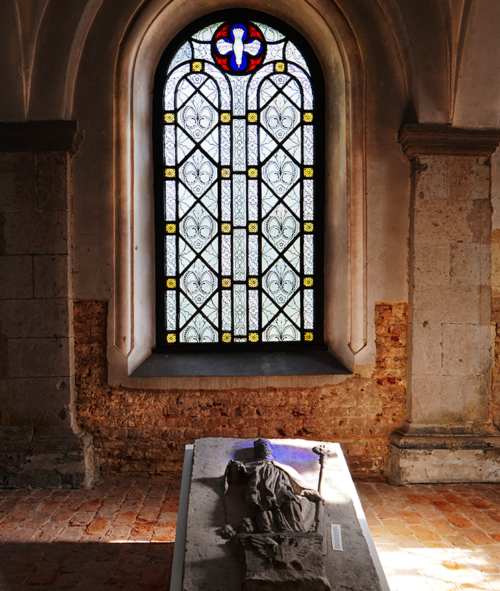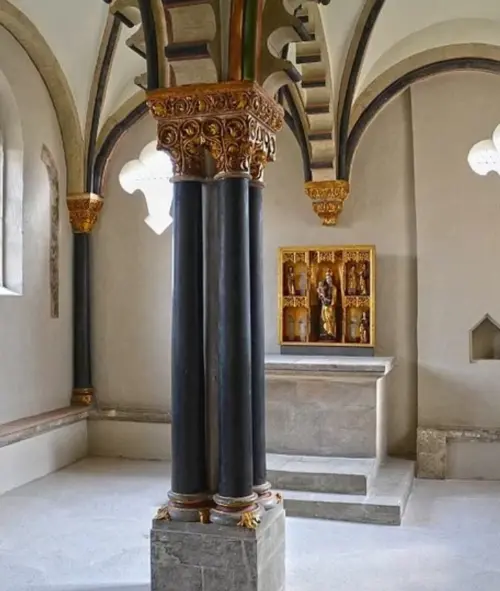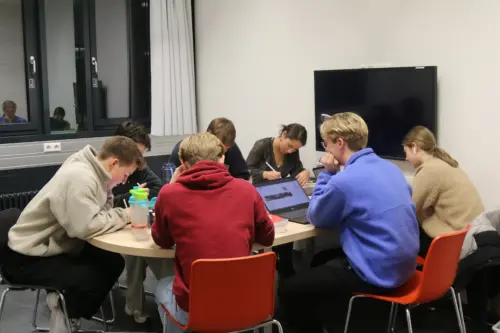Abtei Brauweiler
Brauweiler Abbey
story
In 1024 founded the Count Palatine couple Ehrenfried (called Ezzo) of Lorraine and the
Emperor’s daughter Mathilde founded a monastery in Brauweiler. The founding history of the abbey is like
shrouded in legend in many monasteries.
According to legend, Mathilde is said to be in a dream under the mulberry tree by divine
Inspiration received the order to found a monastery in Brauweiler. Thereupon
Ezzo and Mathilde went on a pilgrimage to Rome and fetched themselves for this
Permission and blessing from the Pope.
On April 14th, 1024 seven monks arrived in Brauweiler and started with the construction
the first monastery complex in Brauweiler. The already existing
Medardus chapel integrated into the building complex. Died during the construction phase
Mathilde and was initially buried in the center of the cloister.
Ezzo equipped the Brauweiler monastery with some goods that made the monastery economical
should hedge. In addition, he placed the goods and the monastery under the protection of the Cologne residents
Church, since it was already foreseeable during his lifetime that his branch of the family would become extinct
would.
A short time later, Richeza, who is now Queen of Poland, joined Mathilde’s daughter
but had to flee Poland after the death of her husband Mieszko II
another patroness of the Brauweiler Abbey.
Richeza bequeathed other goods to Brauweiler, including the Moselle winery Klotten near Cochem.
In addition, Richeza left a new church in Brauweiler after the death of her brother Otto
erect. Parts of this second church building are still standing today. Richeza had to deal with it
Tasked to create a burial place for her family in Brauweiler and determined
that her own corpse should also be buried here. But after her death he left
Archbishop of Cologne at that time the corpse in the new Cologne church St. Maria ad Gradus
burial. Today there is one in the space reserved for Richeza in the Brauweiler crypt
Relic attached to her.
Like all monasteries, the Brauweiler Abbey has been steadily growing over the centuries
and subordinated – not only economically, but also mentally, personally or structurally.
In the 12th century, for example, large parts of the monastery were destroyed by an earthquake
destroyed and had to be rebuilt and under great economic effort
other parts are completely renewed. In this train Abbot Aemilius left the third and last
Erect church building. At the end of the 15th century, another abbot could get grain at times
sell at the highest prices in a famine and thus pay off part of the monastery debt.
But even disasters, wars and epidemics could not prevent the term of office
Abbot Anselm Aldenhovens added a magnificent baroque building to the existing monastery
could be. The foundation stone for this was laid in 1780 by the architect Nikolaus Lauxen
placed. The building was completed as early as 1785.
Only a few years later, Napoleonic France ‘overran’ the Rhineland and occupied it
the Brauweiler Abbey. Between August 3 and 16, 1802, the monastery was dissolved and
the abbey of Brauweiler passed into the possession of the French state.
Almost 800 years of monastic life in the abbey were followed by many years of coercion and
the deprivation of liberty. In 1809 Napoleon had a so-called “beggar’s depot” built in Brauweiler.
In this “Dépôt de Mendicité” mainly homeless people were accommodated. Indeed
as early as 1815 the ownership changed again. Through the Congress of Vienna and the
After Napoleon’s fall, the Rhineland became part of Prussian
Ownership and thus also the Brauweiler Abbey. Starting from the Napoleonic
The Prussian state converted the Brauweiler Abbey into a labor institution.
With a short interruption after the Second World War, this continued to exist until 1969. In it
was tried to people who did not correspond to the social norm
“correct”. The so-called “correctors” should return to society through forced labor
be incorporated. Originated in the former monastery garden and the adjacent land
several establishments of the labor institute. In these commercial establishments, including shoemaking,
In the canning factory, brickworks or agriculture, the inmates had to be heavy in some cases
do physical work.
During the National Socialist regime, individual buildings were built on the site
also as an early concentration camp for political opponents, transit camp for
imprisoned Jews and used as a Gestapo prison. Especially the Gestapo prison
cost several people their lives in Brauweiler. Were trapped in the Brauweiler
Gestapo detained mainly people from resistance circles and forced laborers
Eastern Europe. Probably the most famous prisoner couple in the Gestapo were Auguste and Konrad
Adenauer, who would later become the first Federal Chancellor of the Federal Republic. (Inform
you can find out more about this at the Brauweiler: www.gedenkstaettebrauweiler.lvr.de)
After the end of the Second World War, the abbey was occupied by the British and a so-called
Displaced Persons Camp set up. This was part of the UNRRA. Were accommodated
Here forced laborers and deported people, mainly from Eastern Europe, but also from
other areas formerly occupied by Germany. The aim of the UNRRA mission was the so-called
Repatriation, the return of people to their homeland. With the advance of the
This proved difficult for the Soviet Union in Eastern Europe, however, as some did not return to their homeland
wanted or even could return. This led to recruiting missions
different countries caused the stranded people to emigrate.
When the DP camp was closed in the late 1940s, the work center opened
again their gates. Until the criminal law reform in 1969, forced labor was again used by the
Prostitutes, pimps, alcohol addicts, etc. accommodated here are required. Everything in
Sense of reintegration into society. But the circle of people did not come
more only from the greater Cologne area, but also from federal states without their own work center
delivered their “prisoners” here. So it happened, for example, that the Frankfurter
Prostitute Rosemarie Nitribitt from the State of Hesse accommodated several times in Brauweiler
was to get them to change their way of life.
After the end of the labor institute in 1969, the Rhineland Regional Council (LVR),
which was founded in 1953 and as the successor institution of the Provincial Association, including the
Responsibility for the labor institute had taken over, a psychiatric one in the buildings
State hospital. But its function as a hospital was also short-lived.
Since several grievances occurred, the social framework conditions through the
Psychiatry reform changed in the 1970s, and it eventually became a series of in 1978
Scandals came, the state hospital had to close again in 1978. Crucial for
the closure of the clinic was the overdose of a 20 year old woman and the
Subsequent denunciation of the grievances by the socialist self-help in Cologne
(SSK). This led to investigations by the public prosecutor’s office and the state criminal investigation office
and finally to the condemnation of the responsible doctors and nurses.
The Regional Association of Rhineland began to fundamentally change its use in 1978
of the entire system. The way was clear: no more accommodation for people, none
Forced labor. The idea of building a cultural center was born, and that’s how it began
LVR with extensive restoration and conversion work and provided the abbey
Brauweiler until 1986 in its external appearance based on the baroque
Monastery time again. In the 1990s the Brauweiler Abbey was created for this
Measures awarded several times as an exemplary building. In addition, the LVR brought
some of its cultural services on the grounds of the Brauweiler Abbey at:
LVR-Kulturzentrum Brauweiler Abbey
Since 2009, the former Brauweiler Abbey has had the suffix LVR-Kulturzentrum and
is today as an event and excursion location far beyond the borders of the Rhineland
known. Concerts mainly of classical music including the annual open-air concerts “classic nights” in summer, readings, exhibitions and scientific
Lectures, but also regular public tours of the abbey, the Romanesque one
The church and the Brauweiler Memorial have the historic building complex for the
Open to the public. In addition, themed tours and an audio tour contribute
cultural tourism development of the abbey. The Circle of Friends is an important partner
Brauweiler Abbey e.V. and the Association for History e.V. Pulheim.
The rental of rooms for conferences and celebrations is also of particular importance.
This is also the first time that numerous guests become aware of the cultural offerings.
A total of around 100,000 visits were recorded in 2019.
The LVR-Kulturzentrum Brauweiler Abbey is organizationally part of the LVR archive advice and training center.
LVR archive advice and training center
The LVR Archive Advice and Training Center (LVR-AFZ) is based in
former Brauweiler Abbey. It provides services for the non-governmental archives in the
Rhineland. Its partners and customers include the archives of municipalities, nobility,
Business, churches, clubs, associations and foundations. About 580 archives take the
LVR-AFZ service for the non-governmental archives in the Rhineland. The team
the archives consultancy is available to you in all archiving-technical questions with its know-how as
Contact person available. The training center also offers
Events on current archival topics. In addition, the technical
Center of the LVR-AFZ services in the areas of digitization and
Preservation for the archives in the Rhineland.
LVR Office for Monumentscare in the Rhineland
With over 52,000 registered monuments, the Rhineland is rich in culture and history
Landscape. To describe this inventory, to explore and next to a
continuous support also its value in public through publications,
Conveying lectures and seminars are the essential tasks that the
Monument Protection Act (DSchG NW) of 1980 in North Rhine-Westphalia the two
Has assigned landscape associations with their specialist offices.
In the Rhineland, this is the LVR Office for the Preservation of Monuments, based in the former abbey
Brauweiler.
In the departments of inventory, building and art monument maintenance, documentation and
Experts advise on architectural and art history, technical and restoration
conservation issues.
Archive of the Rhineland Regional Council
Around 200 years of regional self-government in the Rhineland can be found in the archive of
Landschaftsverband Rheinland (ALVR) again. As the central archive of the
The Rhineland Regional Association not only documents the history of the LVR itself,
but also that of its predecessors, the state parliaments and the provincial association
the Rhine Province.
The tradition extends to road and road construction, promotion of agriculture,
Welfare for the poor, youth welfare, the disabled, including schools for the disabled,
Insurance and supply institutions, amelioration and regional planning,
Health care and culture in the former Prussian Rhine province and in
North Rhine part of North Rhine-Westphalia.
The manifestations of the archive material are as varied as the content. In addition to files
and certificates can be found e.g. B. Maps, plans, posters, photographs and films. One
extensive reference library and the acquired library material dissolved
Specialized services round off the range of information.
The use of these stocks is fundamentally available to both science and the
interested citizens.
Carpentry
The joinery is part of the joint management of the two large departments in
Brauweiler and takes care of – like the other craft businesses on the site –
the maintenance of the Brauweiler property.











